Latest posts by (see all)
- The Best Things to Do in Tulsa - June 26, 2020
- The Most Interesting Things to Do in Springfield Mo - June 15, 2020
- Best Things to Do in Salt Lake City - May 26, 2020
- 10 Best Websites for Playing Online Games - May 22, 2020
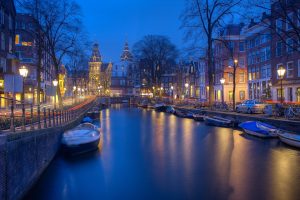 Amsterdam welcomes tourists with diverse and sometimes very unexpected sights: it is a city of canals and memorable bridges, which is so often compared to Venice; the cultural center of the country, where the most famous museums and galleries, classical and innovative theaters, magnificent temples are concentrated; one of the most extravagant European capitals, always attracting nightlife.
Amsterdam welcomes tourists with diverse and sometimes very unexpected sights: it is a city of canals and memorable bridges, which is so often compared to Venice; the cultural center of the country, where the most famous museums and galleries, classical and innovative theaters, magnificent temples are concentrated; one of the most extravagant European capitals, always attracting nightlife.
The peculiar attractions of Amsterdam, for many tourists invariably associated with the free spirit of this city, are the red light districts and coffee shops that legally sell hemp and products made from it. Wonder what else will you see if going to Amsterdam? Check the best things to do in Amsterdam in the list below.
Contents
- Thing to do number 1: Visit the Van Gogh Museum
- Thing to do number 2: Go to the Dam Square in the Heart of Amsterdam
- Thing to do number 3: Go to the Oldest Zoo “Artis”
- Thing to do number 4: Don’t Miss a Chance to See the Royal Palace
- Thing to do number 5: Visit the Erotic Museum
- Thing to do number 6: Go to the Royal Coster Diamonds Factory
- Thing to do number 7: Plunge into Medieval Period in the Amsterdam Dungeon
- Video
Thing to do number 1: Visit the Van Gogh Museum
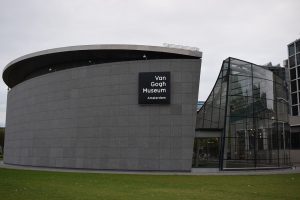 The Van Gogh Museum in Amsterdam has the world’s largest collection of drawings, letters and paintings by the artist. Here, you will find not only his works but also works of his friends – Gauguin, Bernard and others, as well as later masters. This is the most popular place to visit in the Netherlands, which is worth seeing for all tourists. After the death of the creator, in 1890, all his works remained in the family of Brother Theo. But then he died, and his wife John. She took care of the collection, and organized the correspondence by date. The inheritance passed on to their son, who initiated the creation of the museum. Initially, Vincent Willem Van Gogh exhibited canvases at home, then in the city museum, and then agreed with the authorities on the allocation of land for the construction of a separate cultural object.
The Van Gogh Museum in Amsterdam has the world’s largest collection of drawings, letters and paintings by the artist. Here, you will find not only his works but also works of his friends – Gauguin, Bernard and others, as well as later masters. This is the most popular place to visit in the Netherlands, which is worth seeing for all tourists. After the death of the creator, in 1890, all his works remained in the family of Brother Theo. But then he died, and his wife John. She took care of the collection, and organized the correspondence by date. The inheritance passed on to their son, who initiated the creation of the museum. Initially, Vincent Willem Van Gogh exhibited canvases at home, then in the city museum, and then agreed with the authorities on the allocation of land for the construction of a separate cultural object.
You should devote at least 1 hour to view the exposition. The exhibition halls are divided into six main sections, which can also be dated inside. All the works of Vincent Van Gogh. These are letters, drawings and paintings of the artist, since 1864, the last – 1890. Total number – 1439 copies. It is customary to divide into periods:
- “The early period” with the plots of peasant life;
- “Paris” – the beginning of experiments with color and strokes;
- “Arles” – a large number of landscapes and plant motifs;
- “Saint-Remy” – time in a psychiatric hospital, continues to write vivid landscapes;
- The last one – “Over” with a rich palette and energetic strokes.
Interesting: A separate exhibition is dedicated to artists who were inspired by the artist. This is read in the choice of colors, scenes and technique. The collection is replenished and temporary exhibitions are held. Here you can see: Francis Bacon, Edvard Munch, Frank Auerbach, Willem de Kooning and others.
Back
Thing to do number 2: Go to the Dam Square in the Heart of Amsterdam
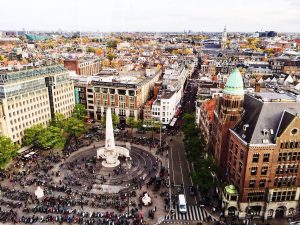 Dam Square is considered to be the ancestor of the capital of the Netherlands. It went through a lot of redevelopment and reconstruction, turning from the fish market into the center of the political, commercial and tourist life of the city. Today, every traveler seeks first of all to visit the square that is the heart of Amsterdam. Locals gather here to celebrate important events and participate in various events. Dame is so popular that you can see it semi-desert only in the early morning, in a strong cold or torrential rain. Attention is drawn to the peacefully neighboring buildings of different eras and styles, unusual monuments, street performers and brave pigeons.
Dam Square is considered to be the ancestor of the capital of the Netherlands. It went through a lot of redevelopment and reconstruction, turning from the fish market into the center of the political, commercial and tourist life of the city. Today, every traveler seeks first of all to visit the square that is the heart of Amsterdam. Locals gather here to celebrate important events and participate in various events. Dame is so popular that you can see it semi-desert only in the early morning, in a strong cold or torrential rain. Attention is drawn to the peacefully neighboring buildings of different eras and styles, unusual monuments, street performers and brave pigeons.
Features of Dam Square:
- The outline of the square in terms of resemble a curved trapezoid.
- The greatest width – from north to south – is 100 meters, and the maximum length – from east to west – about 175 meters.
- Two main highways of Amsterdam adjoin Dame: Rokin street (from the south) – partially runs along the section of the main Amstel river bed covered in 1936. Leads to Monet Square (Muntplein): Damrak Street (from the northeast) – located on the site liquidated in 1845–83. channel.
The roadway located between the streets conditionally divides the area into two sections – the western and the eastern. On the first is Dum Square, on the second – the National Monument. For security reasons, both parts are separated from the roads by concrete blocks and vases with flower arrangements. Dam Square is surrounded by high-rise buildings built in the 15th — 20th centuries. Stylized lampposts stand in front of the Royal Palace. In 2001, asphalt was completely replaced with stone pavement. With de Dam begins most sightseeing tourist routes in Amsterdam. There is something to see, where to go and where to eat.
Interesting: Many special events take place here. Every year on May 4 in Dam Square, there is a ceremony dedicated to the Day of Remembrance of those killed during the Second World War. Before Christmas, a city tree is set up in Dame Square and Christmas markets are organized. In spring and autumn, the territory turns into a fun fair, within which folk festivals, concerts and entertainment shows are held.
Back
Thing to do number 3: Go to the Oldest Zoo “Artis”
 The Royal Artis Zoo is the oldest zoo in the Netherlands, located in the center of Amsterdam. “Artis” is an abbreviation for the full Latin name Natura Artis Magistra, which means “Nature is a mentor of art.” The zoo was opened in 1838. In total, the zoo is home to more than 6 thousand different animals, about 700 species.
The Royal Artis Zoo is the oldest zoo in the Netherlands, located in the center of Amsterdam. “Artis” is an abbreviation for the full Latin name Natura Artis Magistra, which means “Nature is a mentor of art.” The zoo was opened in 1838. In total, the zoo is home to more than 6 thousand different animals, about 700 species.
In addition to the enclosures with animals, you’ll see:
- a planetarium,
- a zoological museum,
- a large aquarium,
- and the only microbial museum in the world called Micropia in the Amsterdam Zoo.
Here you can not only watch the various animals living side by side, but also discover the world of microbes, take a trip to space in the Planetarium, open at the zoo, see how giraffes and zebras coexist in savannah, admire tropical species of fish in a large aquarium. A separate pleasure will bring a walk through the historic city park with its centuries-old trees and unique plants. You can relax and have a snack in the restaurant located here.
Interesting: The original collection, created in 1838, consisted of only a few species, among which were several parrots, monkeys and a wild cat. But a year later, the zoo was supplemented with an elephant, a lion, a panther, a tiger, a bear, a zebra, a kangaroo, and even a five-meter boa. Artis was not originally a private, closed zoo, but was accessible to a wealthy middle class.
Back
Thing to do number 4: Don’t Miss a Chance to See the Royal Palace
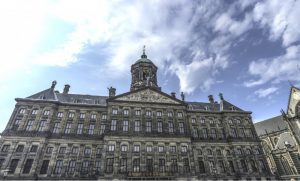 The construction of the Royal Palace belongs to the so-called “Golden Age”, when Amsterdam became one of the most influential cities in Europe, largely due to maritime trade. At this time, not only the economy of the Netherlands reached its peak, but also culture and science. The first stone of the town hall was laid in 1648. The construction of the building was completed by 1665. The building rests on stilts driven under the foundation, their number is almost 14,000. They allow such a large-scale structure to stand firmly in the marshy soil of the city. For the construction of walls used imported sandstone.
The construction of the Royal Palace belongs to the so-called “Golden Age”, when Amsterdam became one of the most influential cities in Europe, largely due to maritime trade. At this time, not only the economy of the Netherlands reached its peak, but also culture and science. The first stone of the town hall was laid in 1648. The construction of the building was completed by 1665. The building rests on stilts driven under the foundation, their number is almost 14,000. They allow such a large-scale structure to stand firmly in the marshy soil of the city. For the construction of walls used imported sandstone.
The architect of the Royal Palace in Amsterdam is Jacob van Kampen. About 150 years in the building sat a body of city government. In 1808, the King of the Netherlands, Louis Bonaparte, brother of Napoleon Bonaparte, decided to change the function of the building – and made it his palace. Thanks to him, elegant furniture in the Empire style appeared here, decorating the halls even now. After the overthrow of Napoleon, the building was returned to the city.
From its inception to the present day, the palace remains one of the most significant and large buildings of the Netherlands. Here such important events take place as the transfer of the throne from one monarch to another and royal weddings. In this palace, the royal family also holds official receptions, for example, in honor of the New Year, various awards ceremonies. For the period of these events and a few weeks before them, the palace is closed to tourists.
Travelers will be able to visit:
- The hall of the Tribunal, where they had previously handed down death sentences. The bas-reliefs here show fair, compassionate, and wise sentences.
- On the first floor, you can go to the Civil Hall – here on the marble floor you will see maps of the earth’s hemispheres and a map of the starry sky.
- In the hall of Moses, the former chamber of the city council, one of the most important historical events took place – in 2013, Queen Beatrix signed a document of renunciation, and her son, Willem-Alexander, ascended to the throne.
- Pay attention to the paintings in the palace – there are works by Rembrandt, Jacob Jordaens, Govert Flink and other prominent artists.
Interesting: You can also purchase a Museum card Museumkaart, which allows you to visit many museums in the Netherlands for free for 1 year, including the Royal Palace in Amsterdam. However, it is not sold in the palace, you need to purchase it in other major museums in Amsterdam. Taking pictures inside the palace is allowed for free, but it is forbidden to use tripods, flash and selfie sticks.
Back
Thing to do number 5: Visit the Erotic Museum
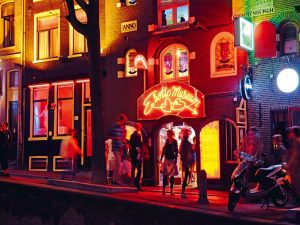 Amsterdam for good reason acquired the glory of “the city of freedom, sin, and love.” Tourists from all over the world come here to look at what in their homeland would cause embarrassment or shame. Why are only the local museums! In addition to the Museum of Eroticism, the Sex Museum, the Museum of Prostitution, and the Museum of Hashish are located nearby – and this is not the most comprehensive list of unusual places that are here. It was here that museums of the same subject began to appear.
Amsterdam for good reason acquired the glory of “the city of freedom, sin, and love.” Tourists from all over the world come here to look at what in their homeland would cause embarrassment or shame. Why are only the local museums! In addition to the Museum of Eroticism, the Sex Museum, the Museum of Prostitution, and the Museum of Hashish are located nearby – and this is not the most comprehensive list of unusual places that are here. It was here that museums of the same subject began to appear.
Erotic Museum in Amsterdam occupies a four-story building of a former warehouse in the Red Light District. The enticing neon inscription Erotic Museum with hearts will not let him miss. Slightly above is an ancient stone tablet with the inscription “The Lord is my Fortress”, which once again underlines the combination of vice and piety characteristic of Amsterdam. Inside the visitor expect explicit exhibits, one way or another connected with sex, prostitution, erotic games and scenes. The entrance to the museum is 18 years old.
The humor and attitude of the Dutch towards sexuality makes the exhibits very challenging for the inhabitant of more conservative countries in this regard. However, having familiarized themselves with the exposition, travelers leave the museum more liberated.
- It is interesting to look at erotic photos from different centuries, to trace the changes in the sexual life of people over time.
- The real historical value is more likely the ancient figurines with erotic scenes, collected from different countries – India, China, Egypt and many others.
- You’ll see Disney’s characters – Snow White and the seven dwarfs, who participate here in a very frank plot, are not deprived of attention. Anyone can even see the film, more clearly demonstrating scenes from the canvas.
- Have a look at the Dutch bikes presented in the Museum, which are used for a more intimate purpose. Only one expression of the cyclist clearly describes everything.
- The fourth floor covered the topic of untraditional sex. Here you can see the various devices for its different types. Do not be surprised at their diversity, in the Red Lanterns and not so practiced. In general, eroticism in the Museum does not imply anything shameful, but rather symbolizes an object of art with its centuries-old history, traditions and deviations.
Interesting: Those interested can leave a souvenir from the museum as a souvenir – an automatic machine with condom toys of various shapes, colors and smells and other interesting souvenirs is working on the floor. By the way, it is allowed to shoot for free here – you can get interesting photos as a keepsake. For example, a snapshot on a BDSM chair, in an embrace with a naked mannequin or a two-meter phallus.
Back
Thing to do number 6: Go to the Royal Coster Diamonds Factory
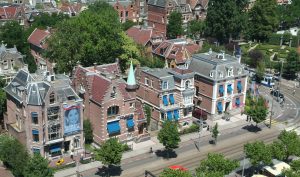 It’s one of the oldest diamond cutting factories still operating in Amsterdam. The country’s history is closely connected with diamonds, so it is not surprising that this is a famous landmark of Amsterdam. It was here that some historical masterpieces were created, such as the “Dresden Green Diamond” belonging to the Saxon dynasty, as well as the newly cut Kohinner diamond, inserted into the crown of Queen Mary, stored in the Tower of London among other British crown jewels.
It’s one of the oldest diamond cutting factories still operating in Amsterdam. The country’s history is closely connected with diamonds, so it is not surprising that this is a famous landmark of Amsterdam. It was here that some historical masterpieces were created, such as the “Dresden Green Diamond” belonging to the Saxon dynasty, as well as the newly cut Kohinner diamond, inserted into the crown of Queen Mary, stored in the Tower of London among other British crown jewels.
Some interesting facts from the history:
- 1840: Diamond Cutter Moses Elias Koster organizes the Bonfire Diamonds workshop in a factory building on Waterloplein Square in Amsterdam.
- 1848: His son Meyer Moses Koster (Martin) inherits his father’s venture. He leaves for Paris, where he opens a new company.
- 1910: Felix Theodor Manus buys Bonfire Diamonds workshop from one of Bonfire’s heirs and transforms it into a company that existed until the German occupation of 1940.
- 1945: After World War II, Wim Biallosterski, owner of a diamond processing company, buys the former Koster Company, which until then was located on Waterloplein.
- 1962: Together with his partners, Max Ment, Johp Skos and Simon Cohen, he purchases the Bonfire premises.
- 1970: The old diamond factory is moved to Paulus Potterstraat (near Musemplein) due to the construction of the Town Hall.
- 1995: Coster Diamonds acquires the well-known enterprise Van Mopps Diamonds.
- 2005: Coster Diamonds forced to close Van Mopps Diamonds factory due to world events such as terrorism and SARS in the Far East, which led to a decrease in the number of clients
- 2007: Opening of the Amsterdam Diamond Museum.
- 2008: creation of a new round shape cut diamond with 201 facets.
Interesting: From 1991 to 1994, Pauline Willems, a diamond cutter at Koster Diamond, cut the smallest diamond in the world with 57 facets and weighing 0.0000743 carats (0.0149 mg), 0.16–0.17 mm in diameter and 0.11 mm high. This case was listed in the Guinness Book of Records.
Back
Thing to do number 7: Plunge into Medieval Period in the Amsterdam Dungeon
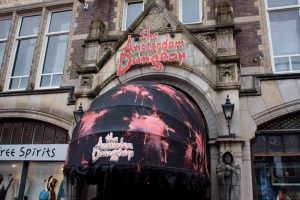 The attraction will allow you to plunge into the dizzying whirlpool of the “Amsterdam Underground”. Here you can trace the origins of the “Merciless Reaper”. Discover its true essence and frailty of being in the darkness of the dungeon.
The attraction will allow you to plunge into the dizzying whirlpool of the “Amsterdam Underground”. Here you can trace the origins of the “Merciless Reaper”. Discover its true essence and frailty of being in the darkness of the dungeon.
- Bloody Tribunal. The bloody tribunal is a glance at Holland of the 16th century and the medieval system of law and order, which enveloped the life of every person with fear.
- Labyrinth of Death. The Amsterdam dungeon challenges you with its infamous “Labyrinth of Death.” It is an incredibly intertwined labyrinth of moves.
- “The Reaper – Journey to Hell”. A gigantic, mantle-clad figure, clutching his scythe, will greet you and indicate places to travel to hell. Incomprehensible power will force you to submit and take your place alongside the other doomed.
- “De VOC souls dealers”. Maritime trade, which was carried out by VOC in the XVII – XVIII centuries, entailed traveling in appalling conditions. Disease and death were commonplace. Find out the whole truth about the unbearable suffering of seamen in the service of VOC.
Interesting: Get ready for stunning stories about historical horrors, eerie rides and disgusting exhibitions. Immerse yourself in the dark medieval times – the era of torture, epidemics and death.